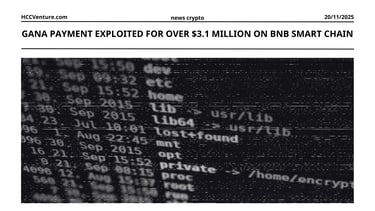GANA Payments Exploited for Over $3.1 Million on BSC
GANA Payment, a decentralized payment protocol on Binance Smart Chain (BSC), has fallen victim to a sophisticated exploit that resulted in over $3.1 million in stolen funds.
11/20/20252 min read


Contract Manipulation and Money Laundering Fast
In the latest blow to on-chain payment infrastructure, GANA Payment, a payments-focused protocol that operates on the BNB Smart Chain (BSC), was exploited for over $3.1 million. The attack, which drained multiple pools in just minutes, highlights the persistent risks facing Web3 payment platforms — especially those deployed on high-throughput chains with large retail user bases.
Withdrawal Phase: The miner withdrew approximately $3.1 million, including staking rewards and pool liquidity, by exploiting a vulnerability in the contract's ownership transfer mechanism.
Money Laundering on BSC: 1,140 BNB (worth about $1.04 million) was deposited into Tornado Cash on BSC to cover its tracks.
Cross-chain bridge: The remainder was transferred to Ethereum, where 346.8 ETH ($1.05 million) was transferred to Tornado Cash, leaving 346 ETH ($1.046 million) dormant in the Ethereum wallet ( 0x7a5…b3cca ).
As the cryptocurrency industry moves toward mainstream financial services, incidents like this raise pressing questions about contract security, treasury management, and the reliability of decentralized payment channels.
GANA Token Price Drops 90% - Liquidity Evaporates
The GANA token (BEP-20 standard) fell more than 90% in just a few hours after the attack, from $0.02 to below $0.002 on GeckoTerminal, wiping out nearly $10 million in market capitalization and causing $5 million in forced liquidations on decentralized exchanges (DEXs) like PancakeSwap.


Trading volume spiked 500% to $15 million, but liquidity pools were 70% depleted, causing spreads to reach 20% — a typical death spiral after an attack.
This follows the BSC vulnerability model. According to DefiLlama’s attack tracker, mid-sized projects lost more than $100 million by 2025, with re-infiltrations and liquidity drains accounting for 40% of incidents. GANA, due to its lack of audits, is a prime example of the risks of unaudited contracts in a chain known for its low barriers to entry but high frequency of exploits.
Impact on BSC Chain and Web3 Payments
The exploit comes at a time when payments networks are becoming a hot sector, with major companies like Circle, Stripe and Western Union launching payment products and stablecoins.
However, the GANA incident exposed the fragility of smaller, less field-tested payment protocols.
This reinforces BSC's reputation as a high-frequency, high-risk environment. Liquidity providers are likely to be more cautious with emerging protocols. Auditing standards are expected to come under criticism again.
Merchants and payment integrators will likely move to tightly regulated enterprise-grade infrastructure. Audited payment channels (like the USDC or L1 merchant API operated by Circle) will gain a competitive advantage.
Disclaimer: The information presented in this article is the author's personal opinion in the cryptocurrency field. It is not intended to be financial or investment advice. Any investment decision should be based on careful consideration of your personal portfolio and risk tolerance. The views expressed in this article do not represent the official position of the platform. We recommend that readers conduct their own research and consult with a professional before making any investment decisions.
Explore HCCVenture group
HCCVenture © 2023. All rights reserved.


Connect with us
Popular content
Contact to us
E-mail : holdcoincventure_contact@hccventure.com
Register : https://linktr.ee/holdcoincventure
Disclaimer: The information on this website is for informational purposes only and should not be considered investment advice. We are not responsible for any risks or losses arising from investment decisions based on the content here.


TERMS AND CONDITIONS • CUSTOMER PROTECTION POLICY
ANALYTICAL AND NEWS CONTENT IS COMPILED AND PROVIDED BY EXPERTS IN THE FIELD OF DIGITAL FINANCE AND BLOCKCHAIN BELONGING TO HCCVENTURE ORGANIZATION, INCLUDING OWNERSHIP OF THE CONTENT.
RESPONSIBLE FOR MANAGING ALL CONTENT AND ANALYSIS: HCCVENTURE FOUNDER - TRUONG MINH HUY
Read warnings about scams and phishing emails — REPORT A PROBLEM WITH OUR SITE.
